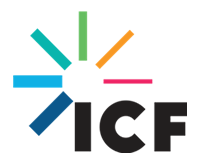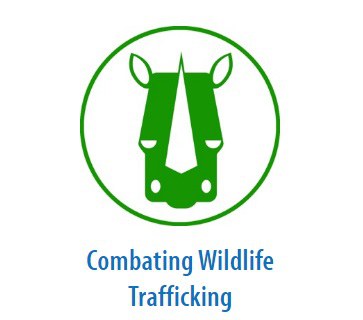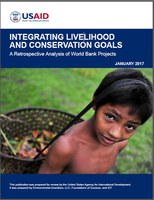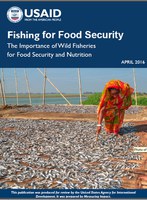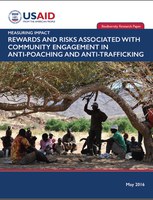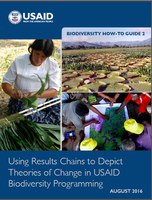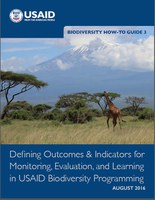Measuring Impact (MI)

Measuring Impact was a six-year contract (2012-2018) that aimed to increase USAID’s capacity to design, monitor, evaluate, and improve the impact of global biodiversity conservation and natural resource management programs. Partners Environmental Incentives, Foundations of Success and ICF International worked with the USAID Bureau for Economic Growth, Education, and the Environment/Office of Forestry and Biodiversity (E3/FAB) to develop effective performance measures, enhance cross-project learning, foster communication, and build capacity for adaptive management. Measuring Impact 2 will build on MI's success.
Biodiversity conservation and natural resources management are integral to advancing human prosperity and enabling resilience in the world’s most vulnerable populations. USAID policy, including the Biodiversity Policy, calls for more strategic, evidence-based and effective programs. Measuring Impact helped USAID operating units meet this call by providing technical assistance with rigorous and well-informed situation analyses, clearly defined theories of change, and results-based performance indicators. Consistent with USAID Forward reforms and the Agency’s Collaborating, Learning, and Adapting approach, these strategies allowed the Agency to improve outcomes through learning and to articulate how conservation supports good development outcomes across sectors.
The Measuring Impact Approach
Measuring Impact provided technical assistance to USAID Missions that program biodiversity funds to achieve four key results:
1. Build Capacity for Best Practices in Implementing the Program Cycle in USAID Biodiversity Programs
Provide technical assistance to Missions and E3/FAB to:
- Strengthen project design based on sound situation analyses and theories of change
- Improve logical and results frameworks and indicators
- Improve monitoring and evaluation frameworks
- Enhance program management practices & processes
2. Improve Biodiversity Conservation Approaches
Help Missions and E3/FAB improve biodiversity program outcomes through systematic learning to:
- Increase USAID’s understanding of conditions under which different conservation actions are effective
- Improve the use of conservation interventions by capturing and sharing evidence across Missions
- Cultivate good learning practices in biodiversity programs that capture institutional knowledge and increase effectiveness
3. Build the Evidence Base
Help USAID develop and use evidence to:
- Illuminate linkages between biodiversity and other sectors
- Fill evidence gaps in understanding the effectiveness of biodiversity conservation approaches
- Create access to evidence and analysis
4. Synthesis and Outreach
Strengthen USAID leadership in evidence-based conservation and development programming by:
- Partnering with key USAID operating units to support use of evidence and best practices
- Developing and disseminating tools and technical guidance resources
- Communicating learning and results
Measuring Impact (MI) Project Resources

Threat Rating Worksheet
When designing biodiversity and integrated biodiversity conservation programs, threat identification and ranking is an essential step to help program design teams decide on what threats to address (and why), and assists on determining what strategic approaches to invest in.

Measuring Impact: Six Years of Improving Conservation at USAID
The Measuring Impact final report highlights six years of designing and implementing evidence-based conservation practices at USAID.

Fishing for Food Security: The Importance of Wild Fisheries for Food Security and Nutrition
The Importance of Wild Fisheries for Local Food Security Briefing Book explores the role of fisheries in global development, showcases case studies of USAID fisheries programs, and addresses the importance of fisheries in nine Feed the Future countries – Cambodia, Senegal, Malawi, Kenya, Ghana, Bangladesh, Tanzania, Mozambique, and Liberia.

Best Practices for Stakeholder Engagement in Biodiversity Programming
Effectively engaging stakeholders is a core component of successful and sustainable biodiversity conservation programs.

Wildlife TRAPS: Revised Monitoring Framework and Midterm Performance Assessment
Wildlife Trafficking Response, Assessment, and Priority Setting (Wildlife TRAPS) was launched in 2013 and is implemented by TRAFFIC, IUCN’s strategic partnership with World Wildlife Fund (WWF).

Integrating Food Security and Wild Caught Fisheries Management in USAID Programming
Integrating Food Security and Wild Caught Fisheries Management in USAID Programming is an illustrative case example that demonstrates how two adaptive management programming tools—situation models and results chains—can help USAID staff and its partners to better design and implement activities that integrate food security, nutrition, and sustainable management of wild fisheries.

Start-Up Guidance for USAID Biodiversity Activities: Process Overview
Start-Up Guidance for USAID Biodiversity Activities: Process Overview describes the main steps to initiate a new biodiversity or integrated activity, including a theory of change workshop.

Tips for USAID Biodiversity Activity Start-Up (Steps 3-5)
This resource provides recommendations for developing theory of change-based activity work plans and monitoring, evaluation, and learning plans using results chains during activity start-up.

Conservation Enterprises: Using a theory of change approach to synthesize lessons from USAID biodiversity projects
In an effort to increase the understanding of conservation enterprises’ activities and outcomes and to improve the effectiveness of biodiversity programming, this brief synthesizes lessons from past USAID-funded efforts to support conservation enterprises.

Building a Conservation Enterprise: Keys for Success
"Building a Conservation Enterprise: Keys for Success” is a summary of the guidance from key resource documents on the enabling conditions that support a sustainable enterprise.

Supplemental Guide 2: Rating Direct Threats in USAID Biodiversity Programming
Biodiversity Programming Supplemental Guide 2: Rating Direct Threats in USAID Biodiversity Programming focuses on the step of threat analysis in biodiversity conservation planning.

Supplemental Guide 1: Defining Scope and Biodiversity Focal Interests in USAID Biodiversity Programming
Biodiversity Supplemental Guide 1: Defining Scope and Biodiversity Focal Interests in USAID Biodiversity Programming focuses on two of the most important initial steps of biodiversity programming: defining the program scope and deciding which elements of biodiversity the program will focus on.

Incorporating Geospatial Analysis into USAID Biodiversity Program Design
Incorporating Geospatial Analysis into USAID Biodiversity Program Design is a biodiversity case example that describes the use of geospatial data and analysis for program design, including examples and lessons learned.

Combating Wildlife Trafficking Cross-Mission Learning Agenda
The CWT Learning Agenda explores assumptions and evidence behind three strategic approaches by outlining key learning questions the Learning Group will collaborate to answer, the learning activities involved, and the intended learning products and outcomes that will result.
Measuring Efforts to Combat Wildlife Crime
New resources to improve how Combating Wildlife Trafficking programs are designed, selected, monitored and evaluated are enhancing USAID’s work and being made available for the wider public through this site.

Miradi User Guide 3: Define Outcomes and Indicators
This guide is one in a series of three designed to provide a general overview of using Miradi Adaptive Management Software.

Miradi User Guide 2: Use Results Chains
This guide is one is a series of three designed to provide a general overview of using Miradi Adaptive Management Software.

Miradi User Guide 1: Develop a Situation Model
This guide is one is a series of three designed to provide a general overview of using Miradi Adaptive Management Software.

Integrating Livelihood and Conservation Goals: A Retrospective Analysis of World Bank Projects
Using a database of World Bank project evaluations, E3/FAB’s new study called “Integrating Livelihood and Conservation Goals: A Retrospective Analysis of World Bank Projects” aims to contribute to building the evidence base around the integration of biodiversity conservation and livelihood goals.




